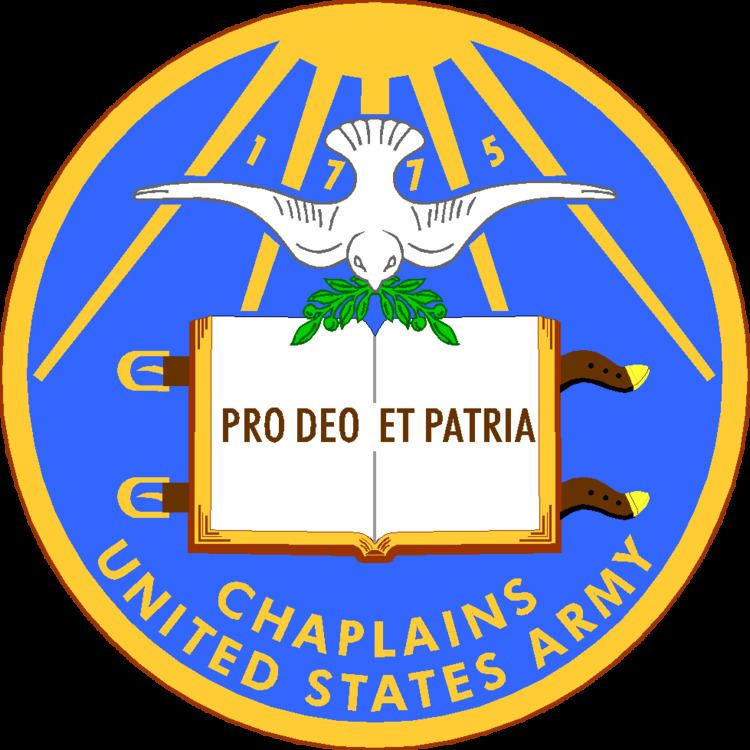Active 29 July 1775 – present | Role Military Chaplaincy | |
 | ||
Allegiance United States of America | ||
The Chaplain Corps of the United States Army consists of ordained clergy who are commissioned Army officers as well as enlisted soldiers who serve as assistants. Their purpose is to offer religious services, counseling, and moral support to the armed forces, whether in peacetime or at war.
Contents
Army Chaplain Center and School
See footnotesThe U.S. Army Chaplain Center and School (USACHCS) is part of the Armed Forces Chaplaincy Center (AFCC), which also includes the Air Force Chaplain Service Institute (AFCSI) and the U.S. Naval Chaplaincy School and Center (NCSC). The three schools are co-located at Fort Jackson, in Columbia, S.C.
In 2005, the Base Realignment and Closure Commission decided to put all military ministry training at the same location.
The purpose of the AFCC is to have closer cooperation among the three chaplain corps and to share instruction and training.
The U.S. Army Chaplain School was approved on 9 February 1918. Its first session began on 3 March 1918, at Fort Monroe, Virginia. Chaplain (MAJ) Aldred A. Pruden, who developed the plan for the school, was named the first commandant of the school. It subsequently moved to Camp Zachary Taylor (Kentucky), Camp Grant (Illinois), Fort Leavenworth (Kansas), Fort Benjamin Harrison (Indiana), Harvard University (Massachusetts), Fort Devens (Mass.), Fort Oglethorpe (Georgia), Carlisle Barracks (Pennsylvania), Fort Slocum (New York) (1951–62), Fort Hamilton (N.Y.) (1962–74), Fort Wadsworth (N.Y.) (1974–79), and Fort Monmouth (New Jersey) (1979–95).
Noncombatant status
See: Military chaplain#Non-combatant statusChaplain Candidate
Due to a revision of DA PAM 611-21 (Military Occupational Classification and Structure) Effective October 1st, 2013, Chaplain Candidates, previously belonging to the Staff Specialist Branch until ordination have worn the Staff Specialist insignia in lieu of religious denomination insignia. The transition from the Staff Specialist Branch to the Chaplain Branch left the candidates without an authorized branch insignia. Responding to the need, Chief of Chaplains Chaplain (Major General) Donald L. Rutherford submitted a request for collar insignia which was approved by HQDA, G-1 on 23 February 2012. The design for the collar insignia was authorized on 18 June 2012.
Religious Affairs Specialist or NCO
Formally called Chaplain assistant.
Specialty insignia
See: United States military chaplain symbolsFor FAQs regarding uniforms and insignia, see footnote.Chiefs of Army Chaplains
The Chief of Chaplains of the United States Army is the head of the Army Chaplaincy. The position was created to better organize the corps. The current Chief of Chaplains is Chaplain (Major General) Paul K. Hurley who was sworn in on May 22, 2015.
Army bases chaplaincy
See footnotesFor a link to the chaplaincy at each of the bases listed below, see general footnote and the footnote following each baseJoint-base chaplaincy
Chapels
For all six USMA chapels, see footnoteChaplains
See footnoteCadet Prayer
See footnoteMuseum
See also: National Museum of the United States Army and Museum of Army Chaplaincy (U.K.)For USA Civil War chaplains, see footnote.For historic photographs of Army chaplains in World War I, World War II, the Korean War, and the Vietnam War, see footnote.The U.S. Army Chaplain Museum is located at Fort Jackson, South Carolina. It was established on 14 August 1957, at the then–United States Army Chaplain School at Fort Slocum, New York. It was dedicated on 10 February 1958, by Chaplain (MG) Patrick J. Ryan, Chief of Chaplains.
"The Four Chaplains"
When the troop-transport ship Dorchester was torpedoed during World War II, four Army chaplains ministered to the soldiers and sailors on the sinking ship, gave up their life jackets, and sacrificed their lives when the ship sank. Those chaplains – known as "The Four Chaplains" – were Lt. George L. Fox, Methodist; Lt. Alexander D. Goode, Jewish; Lt. John P. Washington, Roman Catholic; and Lt. Clark V. Poling, Dutch Reformed.
